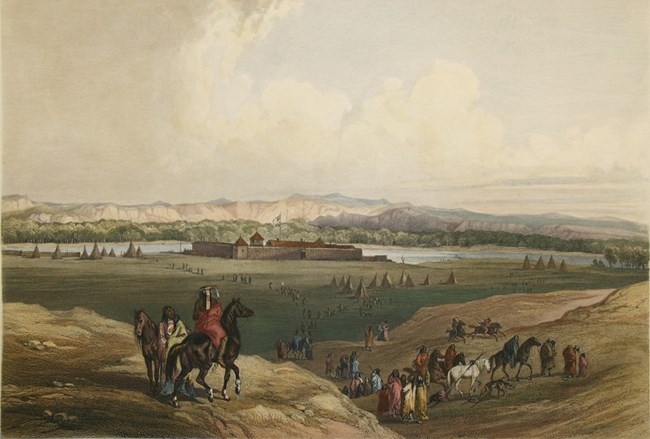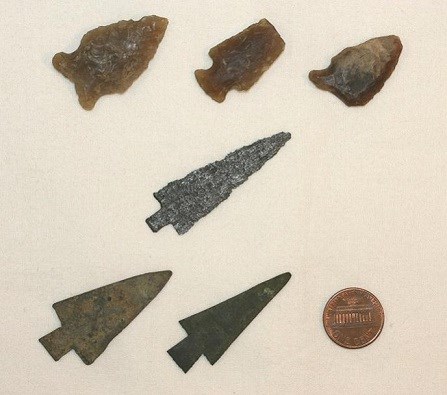Fort Union: The Briefest of Overviews
An 1864 black and white copper plate engraving of John Jacob Astor (FOUS 2818). NPS Photo. Fort Union 1828-1867In 1828, John Jacob Astor's American Fur Company established what would become its most renowned fur trade post near the confluence of the Missouri and Yellowstone Rivers. Although referred to as a fort, Fort Union was not a government or military installation; it was a privately owned commercial establishment created to engage in trade with the Northern Plains tribes. Built at the request of the Assiniboine Nation, Fort Union quickly became the most profitable fur trade post in the Upper Missouri region. The trading activities at Fort Union continued until 1867, fostering a diverse, peaceful, and productive social and cultural environment that contributed to its longevity as the longest-lasting fur trade post in the western United States. From 1828 to 1867, many Upper Missouri tribes—Assiniboine, Crow, Plains Cree, Blackfeet, Plains Ojibwa, Mandan, Hidatsa, Arikara, Lakota and Dakota —traded buffalo hides, beaver pelts, and other furs for numerous goods imported from eight different countries. In exchange for furs that included grizzly bear pelts, bison hides, and smaller animal furs, tribal trading partners received manufactured goods such as calico cloth, firearms and ammunition, clothing, pipes, beads, and cooking supplies. On average, Fort Union received more than 25,000 buffalo robes and generated over $100,000 in merchandise sales each year. Additionally, Fort Union served as a base of operations and storage facility for federal Indian agents before the national government established a permanent presence in the Trans-Mississippi West after the Civil War. 
A lithographic print of "Fort Union on the Missouri" published circa 1843 (FOUS 2761). NPS Photo. Beyond the Fur TradeThe American Indian and fur trades were not the only activities that contributed to Fort Union's lasting legacy. The American Fur Company and its successors regularly hosted notable visitors during the fur trade period. Artists and scientists such as George Catlin, Prince Maximilian of Wied, Karl Bodmer, and John James Audubon came to Fort Union to study and document the region's native peoples, wildlife, and landscapes. Their observations, captured in sketches, paintings, and journals, were shared with audiences in the East and abroad, making the area one of the most well-documented parts of the American West before photography became widespread. By the 1860s, the Upper Missouri region had begun to undergo significant political and social changes. Following the establishment of the Dakota Territory in 1861, settlers migrated westward in increasing numbers. To protect the Missouri River—an essential transportation route to the Northern Plains—and the growing Euro-American settlements that had taken over the previously tribal-controlled Upper Missouri region, the U.S. Army built Fort Buford three miles east of Fort Union in 1866. The following year, in 1867, the Army purchased Fort Union from its last private owner, the Northwest Fur Company. Soldiers dismantled the fort’s palisades and bastions, repurposing the salvaged timber and stone for construction at the new Army post. In addition, passing riverboat crews scavenged wood from Fort Union for firewood to fuel the steam engines of the increasing number of steamboats on the Missouri River. Within a few years, little remained of what was once a dominant commercial hub in the Upper Missouri region. A century later, after numerous attempts to preserve Fort Union's legacy, local citizens and historians initiated a sustained campaign to protect the historic site and rebuild the fort. Their efforts led to the National Park Service acquiring the site in 1966. Archaeological excavations began two years later and continued into the early 1970s. Today's Fort Union is a reconstruction based partly on the archaeological evidence gathered during those digs, as well as follow-up excavations completed between 1986 and 1988. Rebuilt to reflect its appearance in 1851, when the buffalo robe trade was at its peak, Fort Union serves as a vital venue for understanding the fort's role in shaping the land and culture of the Upper Missouri region and the Northern Great Plains. 
NPS Technology and Cultural ChangeThe adoption of metal arrowheads, or projectile points, by the peoples of the Upper Missouri River is a prominent example of cultural change that is discussed at the fort today. Prior to European contact, the Assiniboine and other Northern Plains tribes crafted stone arrowheads using a technique called knapping, where they would chip flakes from a stone core with a harder rock. The three stone arrowheads shown in the top row of the image on the right were discovered by archaeologists at Fort Union and were made from Knife River flint, a strong and durable material quarried 250 river miles to the east of the post and traded upriver. With the establishment of Fort Union, traders introduced the Upper Missouri River peoples to new materials, technologies, and supplies. As trading relationships expanded, the cultural exchange between the tribes and Euro-Americans intensified. The Assiniboine and neighboring tribes increasingly began to purchase and utilize easily made iron, brass, and copper projectile points, similar to the ones also shown in the image. We invite you to explore this site further and discover the people, places, archaeological collections, and stories that illuminate the post's and the region's rich natural and cultural heritage. Detailed information about the fort's reconstruction and historic furnishings can be found on our Fort Union 50th Anniversary pages. We also invite you to help us preserve and share these resources and stories. |
Last updated: December 29, 2024
